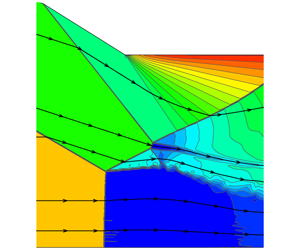Article contents
Double solution and influence of secondary waves on transition criteria for shock interference in pre-Mach reflection with two incident shock waves
Published online by Cambridge University Press: 29 January 2020
Abstract

Mach reflection in steady supersonic flow with two incident shock waves that reflect at the same point on the reflecting surface has been studied recently. Under some conditions we have pre-Mach reflection, where the first incident shock wave produces Mach reflection, the reflected shock wave of which intersects the second incident shock wave, leading to a type I shock interference structure. In this study, we find that a critical condition exists to have a double solution of this shock interference, i.e. we may either have type I interference or type II interference. However, numerical simulation shows that, for inverted Mach reflection, the double solution domain is below the theoretical one and for usual Mach reflection, the double solution domain is above the theoretical one. This discrepancy is found to be due to secondary Mach waves on the initial segment of the slipline of the Mach reflection, thus demonstrating for the first time a case where the transition criterion is modified by secondary Mach waves developed over the primary flow structure.
JFM classification
- Type
- JFM Papers
- Information
- Copyright
- © The Author(s), 2020. Published by Cambridge University Press
References
- 7
- Cited by




